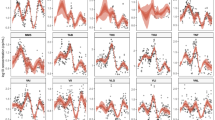Abstract
Stochastic models are used to express pathogen density in environmental samples for performing microbial risk assessment with quantitative uncertainty. However, enteric virus density in water often falls below the quantification limit (non-detect) of the analytical methods employed, and it is always difficult to apply stochastic models to a dataset with a substantially high number of non-detects, i.e., left-censored data. We applied a Bayesian model that is able to model both the detected data (detects) and non-detects to simulated left-censored datasets of enteric virus density in wastewater. One hundred paired datasets were generated for each of the 39 combinations of a sample size and the number of detects, in which three sample sizes (12, 24, and 48) and the number of detects from 1 to 12, 24 and 48 were employed. The simulated observation data were assigned to one of two groups, i.e., detects and non-detects, by setting values on the limit of quantification to obtain the assumed number of detects for creating censored datasets. Then, the Bayesian model was applied to the censored datasets, and the estimated mean and standard deviation were compared to the true values by root mean square deviation. The difference between the true distribution and posterior predictive distribution was evaluated by Kullback–Leibler (KL) divergence, and it was found that the estimation accuracy was strongly affected by the number of detects. It is difficult to describe universal criteria to decide which level of accuracy is enough, but eight or more detects are required to accurately estimate the posterior predictive distributions when the sample size is 12, 24, or 48. The posterior predictive distribution of virus removal efficiency with a wastewater treatment unit process was obtained as the log ratio posterior distributions between the posterior predictive distributions of enteric viruses in untreated wastewater and treated wastewater. The KL divergence between the true distribution and posterior predictive distribution of virus removal efficiency also depends on the number of detects, and eight or more detects in a dataset of treated wastewater are required for its accurate estimation.




Similar content being viewed by others

References
Bosch, A., Guix, S., Sano, D., & Pinto, R. M. (2008). New tools for the study and direct surveillance of viral pathogens in water. Current Opinion in Biotechnology, 19(3), 295–301.
Crainiceanu, C. M., Stedinger, J. R., Ruppert, D., & Behr, C. T. (2003). Modeling the U.S. national distribution of waterborne pathogen concentrations with application to Cryptosporidium parvum. Water Resources Research, 39(9), 1235–1249.
da Silva, A. K., Le Guyader, F. S., Le Saux, J.-C., Pommepuy, M., Montgomery, M. A., & Elimelech, M. (2008). Norovirus removal and particle association in a waste stabilization pond. Environmental Science and Technology, 42(24), 9151–9157.
Dorevitch, S., Pratap, P., Wroblewski, M., Hryhorczuk, D. O., Li, H., Liu, L. C., et al. (2012). Health risks of limited-contact water recreation. Environmental Health Perspectives, 120(2), 192–197.
Emelko, M. B., Schmidt, P. J., & Reilly, P. M. (2010). Particle and microorganism enumeration data: Enabling quantitative rigor and judicious interpretation. Environmental Science and Technology, 44(5), 1720–1727.
European Food Safety Authority (2010). Management of left-censored data in dietary exposure assessment of chemical substances. EFSA Journal, 8(3), 1557.
Haas, C. N., Rose, J. B., & Gerba, C. P. (1999). Quantitative microbial risk assessment. New York: Wiley.
Haramoto, E., Katayama, H., Oguma, K., & Ohgaki, S. (2007). Quantitative analysis of human enteric adenoviruses in aquatic environments. Journal of Applied Microbiology, 103(6), 2153–2159.
Helsel, D. R. (2006). Fabricating data: How substituting values for nondetects can ruin results, and what can be done about it. Chemosphere, 65, 2434–2439.
Kennedy, M. C. (2010). Bayesian modeling of long-term dietary intakes from multiple sources. Food and Chemical Toxicology, 48, 250–263.
Kennedy, M., & Hart, A. (2009). Bayesian modeling of measurement errors and pesticide concentration in dietary risk assessments. Risk Analysis, 29(10), 1427–1442.
Morales-Morales, H. A., Vidal, G., Olszewski, J., Rock, C. M., Dasgupta, D., Oshima, K. H., et al. (2003). Optimization of a reusable hollow-fiber ultrafilter for simultaneous concentration of enteric bacteria, protozoa, and viruses from water. Applied and Environmental Microbiology, 69(7), 4098–4102.
Paulo, M. J., van der Voet, H., Jansen, M. J. W., ter Braak, C. J. F., & van Klaveren, J. D. (2005). Risk assessment of dietary exposure to pesticides using a Bayesian method. Pest Management Science, 61, 759–766.
Perez-Sautu, U., Sano, D., Guix, S., Georg, K., Pinto, R. M., & Bosch, A. (2012). Human norovirus occurence and diversity in the Llobregat river catchment, Spain. Environmental Microbiology, 14(2), 494–502.
Petterson, S. R., Signor, R. S., & Ashbolt, N. J. (2007). Incorporating method recovery uncertainties in stochastic estimates of raw water protozoan concentrations for QMRA. Journal of Water and Health, 5(S1), 51–65.
Rutjes, S. A., van den Berg, H. H. J. L., Lodder, W. J., & de Roda Husman, A. M. (2006). Real-time detection of noroviruses in surface water by use of a broadly reactive nucleic acid sequence-based amplification assay. Applied and Environmental Microbiology, 72(8), 5349–5358.
Sano, D., Perez, U., Guix, S., Pinto, R. M., Miura, T., Okabe, S., et al. (2011). Quantification and genotyping of human sapoviruses in the Llobregat River catchment, Spain. Applied and Environmental Microbiology, 77(3), 1111–1114.
Schijven, J. F., Teunis, P. F. M., Rutjes, S. A., Bouwknegt, M., & de Roda Husman, A. M. (2011). QMRAspot: A tool for quantitative microbioal risk assessment from surface water to potable water. Water Research, 45(17), 5564–6676.
Schmidt, P. J., Emelko, M. B., & Reilly, P. M. (2010). Quantification of analytical recovery in particle and microorganism enumeration methods. Environmental Science and Technology, 44(5), 1705–1712.
Shuval, H. (2003). Estimating the global burden of thalassogenic diseases: Human infectious diseases caused by wastewater pollution of the marine environment. Journal of Water and Health, 1(2), 53–64.
Smeets, P. W. M. H., Dullemont, Y. J., van Gelder, P. H. A. J. M., van Dijk, J. C., & Medema, G. J. (2008). Improved methods for modelling drinking water treatment in quantitative microbial risk assessment: A case study of Campylobacter reduction by filtration and ozonation. Journal of Water and Health, 6(3), 301–314.
Smeets, P. W. M. H., van Dijk, J. C., Stanfield, G., Rietveld, L. C., & Medema, G. J. (2007). How can the UK statutory Cryptosporidium monitoring be used for quantitative risk assessment of Cryptosporidium in drinking water? Journal of Water and Health, 5(S1), 107–118.
Soller, J. A., Schoen, M. E., Bartrand, T., Ravenscroft, J. E., & Ashbolt, N. J. (2010). Estimated human health risks from exposure to recreational waters impacted by human and non-human sources of faecal contamination. Water Research, 44(16), 4674–4691.
Tanaka, H., Asano, T., Schroeder, E. D., & Tchobanoglous, G. (1998). Estimating the safety of wastewater reclamation and reuse enteric virus monitoring data. Water Environment Research, 70(1), 39–51.
Teunis, P. F. M., Xu, M., Freming, K. K., Yang, J., Moe, C. L., & Lechevallier, M. W. (2010). Enteric virus infection risk from intrusion of sewage into a drinking water distribution network. Environmental Science and Technology, 44(22), 8561–8566.
World Health Organization. (2011). Guidelines for drinking-water quality. Geneva: World Health Organization.
Acknowledgments
This study was supported by the Japan Science and Technology Agency through a Grant-in-Aid for Core Research for Evolutionary Science and Technology (CREST), and the Japan Society for the Promotion of Science through Grant-in-Aid for Young Scientist (A) (22686049) and Scientific Research (A) (24246089).
Author information
Authors and Affiliations
Corresponding author
Electronic supplementary material
Below is the link to the electronic supplementary material.
Rights and permissions
About this article
Cite this article
Kato, T., Miura, T., Okabe, S. et al. Bayesian Modeling of Enteric Virus Density in Wastewater Using Left-Censored Data. Food Environ Virol 5, 185–193 (2013). https://doi.org/10.1007/s12560-013-9125-1
Received:
Accepted:
Published:
Issue Date:
DOI: https://doi.org/10.1007/s12560-013-9125-1



